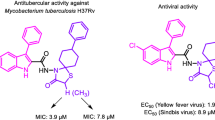Abstract
As a part of our systematic study of antimycobacterially active derivatives of salicylamides, a series of nineteen derivatives of N-(2-pyridylmethyl)salicylamides and N-(3-pyridylmethyl)salicylamides was synthesised. The compounds exhibited in vitro activity against Mycobacterium tuberculosis and M. avium. Their lipophilicity, R M, was measured by thin layer chromatography on silica gel impregnated with trioctadecylsilane and the logarithm of the partition coefficient (octanol-water), logP, was calculated. Both the parameters of lipophilicity correlated. The quantitative relationship between the structure and antimycobacterial activity was calculated. Antimycobacterial activity increased with an increase in lipophilicity. The N-(2-pyridylmethyl)salicylamide derivatives were more active than the derivatives of isomeric N-(3-pyridylmethyl)salicylamides. The geometry of compounds was calculated and the calculation was verified by measuring the length of the hydrogen bond between hydroxyl and carbonyl groups on the salicylic moiety.
Similar content being viewed by others
References
Allen, C. F. H., & vanAllan, J. (1946). Salicyl-o-toluide. Organic Syntheses, 26, 92–94.
Bayer AG. (1975). German Patent No. 2417763. Munich: The German Patent and Trade Mark Office.
Gaylord, N. G., & Kamath, P. M. (1952). p-Chlorophenyl salicylate. Organic Syntheses, 32, 25–26.
Gupta, R. A., Gupta, A. K., Soni, L. K., & Kaskhedikar, S. G. (2009). Study of physicochemical properties-antitubercular activity relationship of naphtalene-1,4-dione analogs: A QSAR approach. Chemical Papers, 63, 723–730. DOI: 10.2478/s11696-009-0080-0.
Hlasta, D. J., Demers, J. P., Foleno, B. D., Fraga-Spano, S. A., Guan, J., Hilliar, J. J., Macielag, M. J., Ohemeng, K. A., Sheppard, C. M., Sui, Z., Webb, G. C., Weidner-Wells, M. A., Werblood, H., & Barrett, J. F. (1998). Novel inhibitors of bacterial two-component systems with gram positive antibacterial activity: Pharmacophore identification based on the screening hit closantel. Bioorganic & Medicinal Chemistry Letters, 8, 1923–1928. DOI: 10.1016/S0960-894X(98)00326-6.
Kaliszan, R. (1987). Quantitative structure-chromatographic retention relationships (pp. 232–278). New York, NY, USA: Wiley.
Macielag, M. J., Demers, J. P., Fraga-Spano, S. A., Hlasta, D. J., Johnson, S. G., Kanojia, R. M., Russell, R. K., Sui, Z., Weidner-Wells, M. A., Werblood, H., Foleno, B. D., Goldschmidt, R. M., Loeloff, M. J., Webb, G. C., & Barrett, J. F. (1998). Substituted salicylanilides as inhibitors of twocomponent regulatory systems in bacteria. Journal of Medicinal Chemistry, 41, 2939–2945. DOI: 10.1021/jm9803572.
Nemeček, P., Ďurčeková, T., Mocák, J., & Waisser, K. (2009). Chemometrical analysis of computed QSAR parameters and their use in biological activity prediction. Chemical Papers, 63, 84–91. DOI: 10.2478/s11696-008-0089-9.
Waisser, K., Bureš, O., Holý, P., Kuneš, J., Oswald, R., Jirásková, L., Pour, M., Klimešová, V., Kubicová, L., & Kaustová, J. (2003b). Relationships between the structure and antimycobacterial activity of substituted salicylanilides. Archiv der Pharmazie, 336, 53–71. DOI: 10.1002/ardp.200390004.
Waisser, K., Hladůvková, J., Kuneš, J., Kubicová, L., Klimešová, V., Karajannis, P., & Kaustová, J. (2001). Synthesis and antimycobacterial activity of salicylanilides substituted in position 5. Chemical Papers, 55, 121–129.
Waisser, K., Peřina, M., Klimešová, V., & Kaustová, J. (2003a). On the relationship between the structure and antimycobacterial activity of substituted N-benzylsalicylamides. Collection of Czechoslovak Chemical Communications, 68, 1275–1294. DOI: 10.1135/cccc20031275.
World Health Organization (2009). Global tuberculosis control: epidemiology, strategy, financing: WHO report 2009. Geneva, Switzerland: WHO Press.
Author information
Authors and Affiliations
Corresponding author
Rights and permissions
About this article
Cite this article
Petrlíková, E., Waisser, K., Palát, K. et al. A new group of potential antituberculotics: N-(2-pyridylmethyl)salicylamides and N-(3-pyridylmethyl)salicylamides. Chem. Pap. 65, 52–59 (2011). https://doi.org/10.2478/s11696-010-0084-9
Received:
Revised:
Accepted:
Published:
Issue Date:
DOI: https://doi.org/10.2478/s11696-010-0084-9




